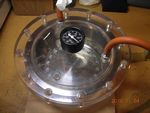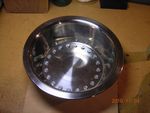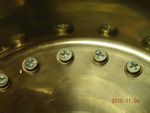

| ▲ Workshop |
A big problem in mouldmaking, plaster casting etc. is the presence of trapped air bubbles and dissolved air in the mixture. An extremely effective way of removing these is to apply a vacuum to the mixture. This has two effects. Firstly, trapped air bubbles increase in size and rise much faster to the surface. Second, the solubility of dissolved air in the mixture is reduced by the lower pressure, casing dissolved air to come out of solution, form bubbles and also rise to the surface. When atmospheric pressure is re-applied, any remaining bubbles are squashed to an insignificant size.
The classy way of doing this is to use a belljar and metal baseplate with vacuum and vent connections. I couldn't be bothered rigging up something that fancy, so I made a quick lash-up instead. The lid of the chamber is a disc of 1" acrylic I got out a skip years ago. It carries a vacuum gauge and the two vacuum/vent connections. Valves are simply screw clamps on the rubber tubing. The chamber is a large (8" diameter) stainless-steel dog bowl. The flat rim of the bowl forms a perfect seal against the underside of the acrylic and no gasket is needed. The bottom of the bowl, being rather thin, nearly collapsed totally when I first applied vacuum so I screwed it down to a piece of ¾" MDF. I used countersunk screws with a washer - this seems to result in an airtight seal when they're tightened down. No sealant is used under the screws. Twenty screws might seem overkill, but remember there's nearly 200 kg trying to pull the bottom in!
It works really quickly. With a relatively small vacuum pump (not much bigger than an HVAC pump) I can get a vacuum low enough to boil water in under 30 seconds. That indicates I'm getting better than about 17 Torr, since that's the vapour pressure of water at 25°C.
 |
 |
 |
| ▲ Workshop |